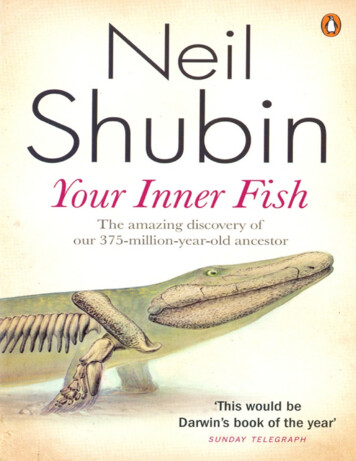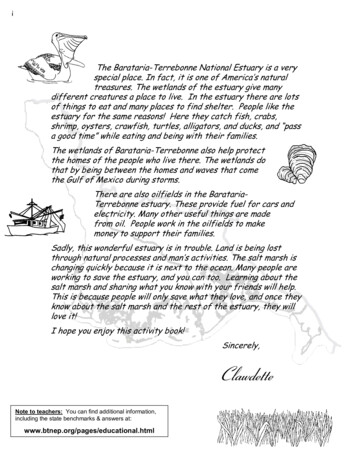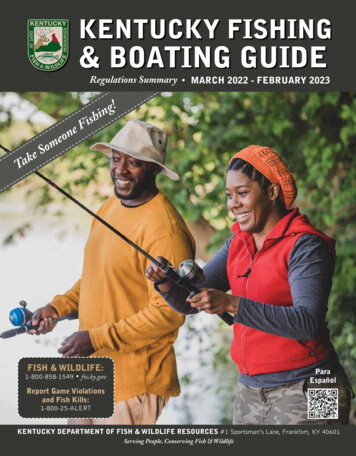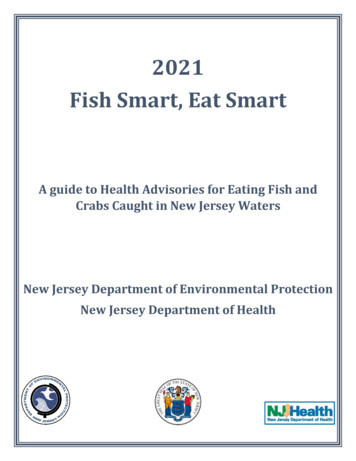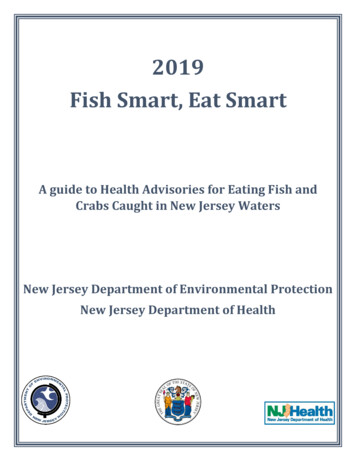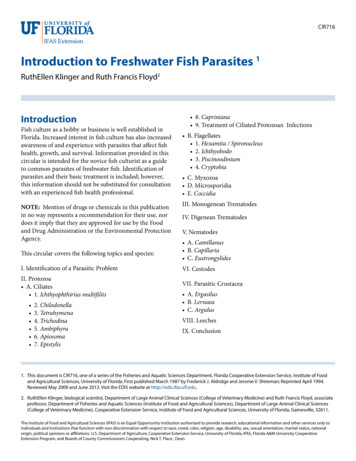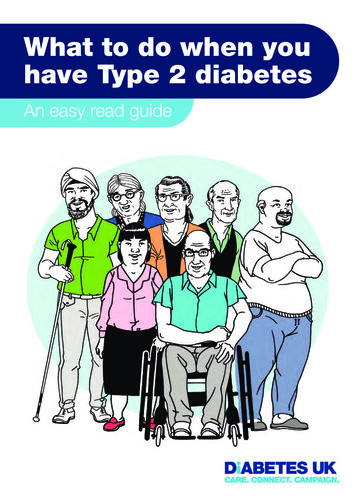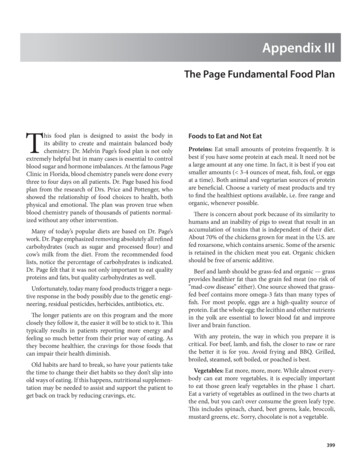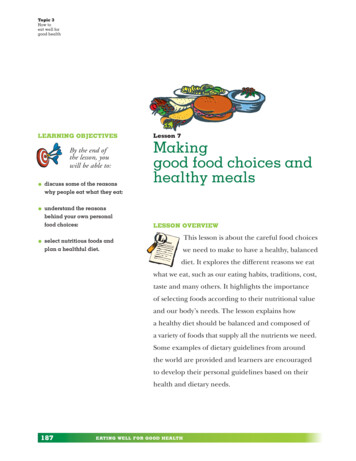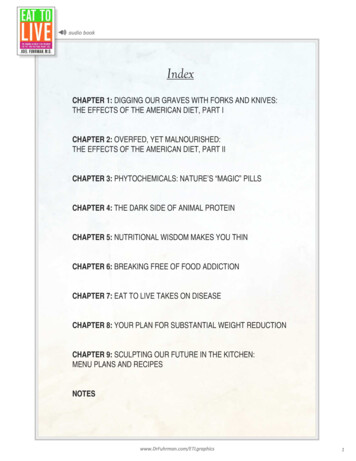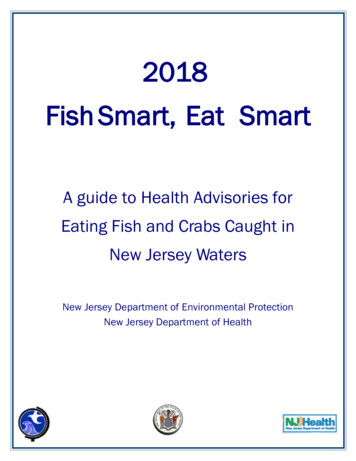
Transcription
2018Fish Smart, Eat SmartA guide to Health Advisories forEating Fish and Crabs Caught inNew Jersey WatersNew Jersey Department of Environmental ProtectionNew Jersey Department of Health
ContentsIntroduction . 1General Consumption Guidelines . 2Health Effects from Consumption of Contaminated Fish and Crabs . 2Preparation and Cooking Methods for Fish and Crabs under Advisory . 3Federal Advice on Fish Consumption . 42018 Fish Consumption Advisory Table .5Map of New Jersey Advisory Waters 73Statewide Water Body Locations .74The New Jersey Department of Environmental Protection and the New Jersey Department of Health can provide moreinformation on the advisories and the health effects of chemical contaminants in the fish. To stay current with advisoryupdates and to request additional information, please contact the NJDEP, Division of Science, Research andEnvironmental Health at 1-609-984-6070 or check the website www.FishSmartEatSmartNJ.org or the NJDOH at(609) 826-4935.
IntroductionThis 2018 update uses the results of a study involving theanalysis of samples of fish species collected from lakes, rivers,ponds and reservoirs that flow within the New Jersey CoastalPlain region. This information was used to support thecontinuation and revision of the current fish consumptionadvisories for this region, and identified the need for additionalfish consumption advisories.This booklet summarizes the marine, estuarine and freshwaterfish consumption advisories for New Jersey. It provides you withinformation on how to reduce your risk by avoiding or limitingconsumption of certain fish. It also offers guidance in how toprepare the fish you eat from local waters in ways that reduceyour exposure to PCBs, dioxins and other contaminants.Fishing provides enjoyable and relaxing recreation. Manypeople enjoy cooking and eating their own catch. Fish are anexcellent source of protein, minerals and vitamins, are low infat and cholesterol and play an important role in maintaining ahealthy, well-balanced diet. The American Heart Associationrecommends people eat fish regularly. Fish are also one of thefew foods that are rich in the omega-3 fatty acids needed forproper development of the brain and nervous system in thefetus and infants and may reduce the risk of heart attack. Fishare an excellent substitute for other protein foods that arehigher in saturated fats and cholesterol. Health professionalsrecommend that you include fish in your diet.However, certain fish may contain contaminants, such aspolychlorinated biphenyls (PCBs), dioxins and mercury from thewater they live in and the food they eat. Contaminants such asdioxin and PCBs are classified by the U.S. EnvironmentalProtection Agency as probable cancer causing substances inhumans. Elevated levels of mercury can pose health risks to thehuman nervous system, particularly to developing fetuses.Therefore, it is a good idea to follow a few precautions inconsuming recreationally caught fish and crabs, particularly ifyou eat them often.Since 1982, when research began to show elevated levels ofpotentially harmful contaminants in certain fish and crabs insome New Jersey waters, fish consumption advisories wereadopted to guide citizens on safe consumption practices. Fishconsumption advisories are developed through a scientificprocess that includes collecting samples of fish from watersthroughout the state and analyzing them for various chemicalcontaminants, such as dioxin, PCBs and mercury. Thecontaminant levels in the fish are then evaluated using stateand federal guidelines for protecting human health.The New Jersey Department of Environmental Protection(NJDEP) and Department of Health (NJDOH) provide advice onconsuming those species of fish in which high levels of dioxin,PCBs and mercury have been found.Since levels of contaminants may vary from one location toanother and from one fish species to another, the advisoriesare also separated by site. So be sure to check whichguidelines refer to your fishing location.2018 Fish Consumption Advisories for PCBs,Dioxin and MercuryThe advisory table in this booklet provides statewide, regional,and water body-specific advisory information for various fishspecies. The table lists the recommended fish consumptionfrequencies for the General Population and High-riskIndividuals for waters statewide and for specific water bodies.High Risk Individuals: Includes infants, children, pregnantwomen, nursing mothers and women of childbearing age.General Population: Includes all others not in the high-riskcategory.All fish consumption advisories are presented in mealfrequencies (for example: one meal per month or four mealsper year). For PCB advisories this range is based on anestimated 1 in 10,000 risk of cancer during your lifetime fromeating fish at the advisory level. This means that one additionalcancer may occur in 10,000 people eating fish at the advisorylevel for a lifetime.By using this advisory, you have the necessary information tomake an informed choice on the number of meals of fish toconsume. You can reduce your risk further by eating less thanthe advisory meal frequency, however, this need to be balancedwith the health benefits of eating fish.The limits that follow each species assume that no othercontaminated fish are being eaten. If you eat more than onespecies of fish listed in the advisory, the total consumption offish should not exceed the recommended frequency as aguideline for consumption. The best approach is to use thelowest recommended frequency as a guideline forconsumption. Example: If you fish Union Lake, and you are inthe general population category, you can eat four meals ofwhite perch or you can eat one meal of Largemouth Bass overthe course of a month, but not both.-12018—Fish Smart, Eat Smart
If your specific fishing location is not mentioned within theadvisories on the following pages, this does not mean the fishare free of contamination. Not all New Jersey waters or fishspecies have been tested, and not all fish species were found inall locations, or in some cases available data were insufficient tolist a species for a specific water body. Follow the statewideadvisory for the listed species if your fishing area is notmentioned in the guidelines, or follow the statewide advisory ofone meal per week for (general Population) or one meal permonth (high-risk individuals) for freshwaters.MercuryMercury is a toxic metal that has been commonly used in anumber of products (e.g., thermometers, electrical switches).There are many sources of mercury in the environment, naturaland man-made; primary sources include burning of fossil fuelssuch as coal, incineration of wastes, and metal processing/manufacturing.NJ has taken aggressive action toreduce sources of mercury in the state. Levels ofmercury from in-state air sources have beenreduced by over 90% since the 1990s. Currentsources of mercury to NJ are primarily from otherstates’ air emissions (e.g., coal power plants) andnatural emissions.General Consumption GuidelinesFish Species: Contaminant levels may vary from speciesto species. If possible, eat smaller amounts of several differenttypes of fish rather than a large amount of onetype that may be high in contaminants. Try to focus yourconsumption on those species of fish that have lower levels ofcontaminants, such as fluke or flounder.Fish Size: Smaller fish of a species will usually have lowerchemical levels than larger fish in the same location becausecontaminants tend to build up in the fish over time. It is advisableto eat smaller fish (of legal size) more often than larger fish.High-risk Individuals: Infants, children, pregnant women, nursingmothers and women of childbearing age are considered to be athigher risk from contaminants in fish than members of thegeneral public. People within this category should be particularlycareful about following the advisories, because of the greaterpotential for PCBs, dioxin and mercury to affect the developmentof the fetus, infant, and young child.Subsistence Fishing: Avoid subsistence level (relying on wildcaught fish for daily nutritional needs) fishing activities in largerivers within or immediately downstream of large urban/industrial areas and wastewater outfalls. Fish in these areas aremore likely to contain traces of chemical contaminants.Health Effects from Consumption ofContaminated Fish and CrabsGeneral AdviceExposure to low levels of some contaminants in the environmentmay have long lasting health effects on people. Mercury, PCBsand dioxins are among the major contaminants found in someNew Jersey fish in portions of the state. These contaminants canbe especially harmful to women of childbearing age, pregnantwomen and nursing mothers. Trace amounts of thesecontaminants may remain in your body for a period of time aftereating. Should you become pregnant during this time, thesecontaminants can be passed along to your fetus, potentiallyaffecting the development of the nervous system. Children arealso at risk of developmental and neurological problems ifexposed to these chemicals.Mercury discharged to the environment can end up in local waterbodies. Mercury accumulates in fish muscle tissue through theaquatic food chain from the food that fish eat. Above certainlevels, mercury can damage the nervous system, particularly inunborn and young children, resulting in learning anddevelopmental delays. Regular consumption, of even lowamounts of mercury may cause subtle effects on the centralnervous system in both children and adults. In addition, long-termconsumption of fish with elevated levels of mercury by adults andolder children may result in adverse health effects, includingneurological damage. For more information go to: www.epa.gov/mercury.PCBsPolychlorinated biphenyls (PCBs) were commercially produced forindustrial application in heat transfer systems, hydraulic fluidsand electrical equipment. They were later incorporated into otheruses such as printing inks, paintsand pesticides. The manufacture of PCBs was stopped in 1979as a result of evidence that PCBs build up in the environment andcause harmful effects. PCBs tend to stay mostly in soil andsediment, but are also found in the air and water.Once they enter the food chain, they have a tendency to absorbinto fat tissue. PCBs build up in fish to levels that are hundreds ofthousands of times higher than the levels in the surroundingwater. When people consume fish that have already accumulatedPCBs, the PCBs then accumulate in their bodies.-22018—Fish Smart, Eat Smart
PCBs have been shown to cause cancer in animals, and there isevidence that PCBs may cause cancer in exposed humans. PCBshave also been shown to cause a number of serious healtheffects besides cancer in humans and animals, including effectson the nervous system of the developing fetus, the immunesystem, and the reproductive system. Studies have shown thatunborn and young children are most at risk to PCB exposure.Because PCBs take a long time to leave the body after theyaccumulate, women who plan to become pregnant should followthe morerestrictive consumption advice before becoming pregnant. Formore information go natedbiphenyls-pcbsDioxinDioxin is the most toxic member of a large chemical family ofrelated dioxins and furans. Dioxin is an unwanted industrialbyproduct formed through numerous processes, includingproduction of chlorinated phenol products such as herbicides,the incineration of municipal solid waste, and creation of paperproducts using bleach. Most of what we know about dioxin hasbeen obtained through animal toxicity testing in the laboratoryand representative wildlife species. Dioxin produces a numberof effects in animal testing, including suppression of theimmune system, impaired reproduction, birth defects in somespecies tested, a skin condition called chloracne, alterations inliver function, and cancer. The federal Environmental ProtectionAgency (EPA) has classified dioxin as a probable humancarcinogen. For more information go to: lfishPFOSPFOS (perfluorooctane sulfonate) is a member of a larger groupof chemicals known as PFAS (per- and polyfluoroalkylsubstances). PFOS has been used in a variety of consumerproducts and industrial applications including water/stainresistant clothing, and aqueous film-forming foams employed infirefighting primarily at military bases and civilian airports. PFOSthat is released into the environment can contaminate surfacewater as well as groundwater used as drinking water sources.PFOS that enters surface waters can accumulate in freshwaterfish. Consumption of fish from contaminated waters can lead toexposure to PFOS at levels that may cause health concerns.Studies in human populations exposed to PFOS have identified anumber of health effects that are associated with PFOS. Themost sensitive of these effects involve effects on the immunesystem, including decreased vaccine response and increasedincidence of childhood infections that are associated withmaternal exposure during pregnancy. Studies have alsoidentified increased serum uric acid/hyperuricemia as well asincreased total cholesterol. Animal studies have also shown thatthe immune system is very sensitive to PFOS which causesdecreased response to foreign substances. In addition, animalstudies have also identified effects of PFOS on the liver andthyroid hormones. Developmental effects have also beenobserved in the offspring of pregnant animals exposed to PFOS.Because PFOS can cross the placenta, consumption of PFOScontaminated fish by pregnant women and women ofchildbearing age places them in a high risk population categoryfor fish consumption advisories. The health effects from otherPFAS may differ somewhat from those for PFOS, but all havethe ability to cross the placenta, and therefore, also placepregnant women and women of childbearing age in the highrisk population category.Preparation and Cooking Methods for Fish andCrabs under AdvisoryThe best way to reduce exposure to contaminants infish is to learn what fish species are affected andeither limit or avoid consumption. However, if you musteat those species under advisories, there are steps youcan take to reduce your exposure. Contaminants tendto concentrate in thefatty tissue of the fish you catch. Proper cleaning and cookingtechniques, which remove some of the fat fromthe fish, can significantly reduce levels of PCBs,dioxins and other organic chemicals. Please note,however, thatthese techniques will not reduce or remove unsafelevels of mercury from these fish. Mercury occurs in the flesh.There is no way to remove mercury throughcooking. The best way to reduce mercury exposure isto select those species of fish which are known to have lowerlevels of mercury.Fish Preparation MethodsProper fish cleaning and cooking techniques mayreduce PCB levels by approximately 50 percent when comparedto raw fish fillets. A meal size is consideredto be an uncooked 8 ounce fillet.Eat only the fillet portions. Do not eat whole fish or steakportions.Many chemical contaminants, like PCBs and pesticides (but notmercury), are stored in the fatty portions of fish. To reduce thelevels of these chemicals, skin the fish and trim any of the darkmeat (lateral line), back strap and belly flap. The followingdiagram illustrates those body portions.allfat -the fattymeat along theentiretheallfat alongbellyDo not eat the heads, guts or liver, because PCBs usuallyconcentrate in those body parts. Also, avoid consumption ofany reproductive parts such as eggs (roe).-32018—Fish Smart, Eat Smart
Fish Cooking MethodsUse a cooking method such as baking, broiling, frying,grilling, or steaming that allows the fats and juices to drainaway from the fish. When possible, cook the fish on anelevated rack that allows fats and juices to drain to thepan below.Avoid batter, breading or coatings that can hold in thejuices that may contain contaminants. The juices shouldbe thrown away since they contain the PCBs and otherchemicals that were in the fat. Do not pour these juicesover the fish as a sauce or to moisten the fish. Butter,margarine or other liquids can be added to the fish for thispurpose once the juices have been poured off. Aftercooking, discard all liquids and frying oils. Do not reuse.Do not use heads, skin, trimmed fatty portions in soups,stews, chowders, boils, broth or for fish stock. If youmake stews or chowders, only use skinless fillet parts.Raw fish may be infested by parasites. Cook fishthoroughly to destroy the parasites. This also helps toreduce the level of many chemical contaminants.See brochures on the FishSmartEatSmartnj.orgwebsite for instructions on ways to properly cleanand cook fish and crabs.Crab —EnglishCrab l Advice on Fish ConsumptionThe following is provided as general information and advicefrom the federal government.Do not eat Shark, Swordfish, King Mackerel, Marlin, OrangeRoughy, Bigeye Tuna or Tilefish (Gulf of Mexico) because theycontain high levels of mercury. Note: No advisory for Tilefishharvested from the mid-Atlantic and southern New Englandarea.Crab Preparation MethodsWhat Pregnant Women & Parents Should KnowEating, selling or taking (harvesting) blue crabs from NewarkBay Complex and the tidal Passaic River is prohibited. TheNewark Bay Complex is located in northeastern New Jersey. Itincludes the Newark Bay, tidal Hackensack River, Arthur Kill, KillVan Kull and tidal tributaries. (See chart on page 6.) If blue crabsare taken from water bodies other than the Passaic River/Newark Bay Complex, the following preparation techniques canbe followed to reduce exposure to some contaminants.The highest levels of chemical contaminants are found in thehepatopancreas, commonly known as the tomalley or greengland. It is the yellowish green gland under the gills. Thismaterial is found next to the lump meat (backfin) portion of thecrab. Chill and break the crabs immediately before cooking.Care must be taken to remove all of the hepatopancreas beforecooking.There is no specific cooking method available to reduce thechemical contaminant levels in blue crabs. The following stepsfor proper preparation are key to reducing your exposure toharmful chemical contaminants.Do not eat the green gland (hepatopancreas). Remove greengland (hepatopancreas) before cooking. After cooking, discardthe cooking water. Do not use cooking water or green gland(hepatopancreas) in any juices, sauces, bisques or soups.Fish and other protein-rich foods have nutrients that can helpyour child’s growth and development.For women of childbearing age (about 16-49 years old),especially pregnant and breastfeeding women, and for parentsand caregivers of young children. Eat 2 to 3 servings of fish a week from the “Best Choices” listOR 1 serving from the “Good Choices” list.(See the FDA and EPA list regarding eating fish at: ucm393070.htm) Eat a variety of fish Serve 1 to 2 servings of fish a week to children, starting atage 2. If you eat fish caught by family or friends, check for fishadvisories. If there is no advisory, eat only one serving andno other fish that week.Additional information on mercury in seafood can be foundat the FDA’s web site: /ucm393070.htmFor more information on EPA freshwater fish consumptionadvisories, go to https://www.epa.gov/fish-tech-42018—Fish Smart, Eat Smart
2018 NEW JERSEYFISH CONSUMPTION ADVISORIES(Note: New or Updated Advisories are noted next to species)STATEWIDE ESTUARINE AND MARINE WATERSApplies To All Coastal Waters Except the WATERBODY SPECIFIC ADVISORIESGeneral Population-SpeciesEat No More Than:High Risk Population(2,3)Eat No More Than:Striped BassOne meal per monthDo Not EatAmerican EelFour meals per yearDo Not EatSix meals per yearDo Not EatOne meal per monthDo Not EatBluefish—(greater than 6lbs./24 inches)Bluefish—(less than 6lbs./24 inches)American Lobster(1)(2,3)Do Not Eat the Green GlandDo Not Eat the Green Gland(a.k.a., Tomalley or Hepatopancreas)(a.k.a., Tomalley or Hepatopancreas)(1) High-Risk Individuals include infants, children, pregnant women, nursing mothers and women of childbearing age.(2) One meal is defined as an eight-ounce serving.(3) Eat only the fillet portions of the fish. Use proper trimming techniques to remove fat, and cooking methods that allow juices todrain from the fish (e.g., baking, broiling, frying, grilling, and steaming). See text for full description.(4) Sunfish includes bluegill, pumpkinseed, and redbreast sunfish species.(5) No harvest means no taking or attempting to take any blue crabs from these waters.* Selling these species for human consumption from designated New Jersey waters is prohibited.Notes: Not all fish species available were collected and/or analyzed from all waterways-52018—Fish Smart, Eat Smart
WATERBODY SPECIFIC ADVISORIESESTUARINE and MARINE WATERSALSO SEE ALL STATEWIDE ESTUARINE AND MARINE ADVISORIESNewark Bay ComplexIncluding Newark Bay, tidal Hackensack River, Arthur Kill, Kill Van Kull and alltidal tributariesGeneral Population-SpeciesHigh Risk Population-Eat No More Than:Blue Crab*Do not Harvest or EatStriped Bass*Eat No More Than:5Do not Harvest or EatFour meals per yearDo Not EatWhite PerchDo Not EatDo Not EatWhite CatfishOne meal per yearDo Not EatAmerican EelDo Not EatDo Not Eat5Passaic River (Tidal)From the head of tide at Garfield to Newark Bay and all tidal TributariesSpeciesBlue Crab*General Population-High Risk Population-Eat No More Than:Eat No More Than:Do not Harvest or EatAll Finfish & Shellfish*5Do Not EatDo not Harvest or Eat5Do Not EatHudson RiverFrom the NY-NJ borderline (near Alpine, NJ) downstream of the NY-NJ borderline on theUpper New York Bay (at Bayonne, NJ)General Population-High Risk Population-Eat No More Than:Eat No More Than:Four meals per yearDo Not EatWhite PerchOne meal per yearDo Not EatWhite CatfishDo Not EatDo Not EatOne meal per yearDo Not EatOne meal of 7 crabs per week -One meal of 7 crabs per week -Do not eat Green Gland (hepatopancreas)Discard cooking liquidDo not eat Green Gland (hepatopancreas)Discard cooking liquidOne meal per monthOne meal per monthSpeciesStriped Bass*American Eel *Blue CrabWinter Flounder-62018—Fish Smart, Eat Smart
WATERBODY SPECIFIC ADVISORIESESTUARINE and MARINE WATERSALSO SEE ALL STATEWIDE ESTUARINE AND MARINE ADVISORIESRaritan Bay ComplexIncludes the Raritan Bay, tidal Raritan River (up to the Rt. 1 bridge) and all tidal tributaries)General Population-High Risk Population-Eat No More Than:Eat No More Than:Summer Flounder(Fluke)One meal per weekOne meal per weekStriped BassOne meal per monthDo Not EatOne meal per yearDo Not EatNo restrictionsOne meal per monthOne meal per monthDo Not EatOne meal per yearDo Not EatSpeciesWhite Perch(also see below—South River)Redbreast SunfishChannel CatfishAmerican EelBlue CrabOne Meal of 7 Crabs per monthDo not eat Green Gland (hepatopancreas) Discardcooking liquidOne meal per monthDo Not EatWinter FlounderOne meal per monthOne meal per monthPorgyOne meal per monthOne meal per monthCommon CarpOne Meal per weekDo not eat Green Gland (hepatopancreas) Discardcooking liquidUpdated-2018One Meal of 7 Crabs per monthDo not eat Green Gland (hepatopancreas) Discardcooking liquidWeakfishAmerican LobsterNew-New AdvisoryRevised- Advisory changedUpdate- New data-No changein advisoryOne Meal per weekDo not eat Green Gland (hepatopancreas) Discardcooking liquidOne meal per monthRevised-2018One meal per monthRaritan River and South RiverSpecies(Tidal portion) upstream of Rt 35 Bridge and tidal South RiverHigh Risk PopulationGeneral Population-New-New AdvisoryRevised- Advisory changedUpdate- New data-No changein advisoryEat No More Than:Eat No More Than:White PerchFour meals per yearDo Not EatRevised-2018White CatfishFour meals per yearDo Not EatRevised-2018Sandy Hook Bay & Lower BaySpeciesSummer Flounder (Fluke)General Population-High Risk Population-Eat No More Than:Eat No More Than:One meal per weekOne meal per week-72018—Fish Smart, Eat Smart
WATERBODY SPECIFIC ADVISORIESESTUARINE and MARINE WATERSALSO SEE ALL STATEWIDE ESTUARINE AND MARINE ADVISORIESBarnegat Bay at Manahawkin BaySpeciesWeakfishGeneral Population-High Risk Population-Eat No More Than:Eat No More Than:One meal per weekOne meal per monthBarnegat Bay at Toms RiverSpeciesStriped BassGeneral Population-High Risk Population-Eat No More Than:Eat No More Than:No restrictionsOne meal per monthAtlantic Ocean—Sandy Hook to Sea BrightSpeciesSummer Flounder (Fluke)General Population-High Risk Population-Eat No More Than:Eat No More Than:One meal per weekOne meal per weekAtlantic Coastal TributariesIncluding the Navesink River, Shrewsbury River, Shark River, Toms River & Mullica RiverSpeciesAmerican EelGeneral Population-High Risk Population-Eat No More Than:Eat No More Than:One meal per monthOne meal per monthAtlantic Ocean—Sea Isle City to Cape MaySpeciesWeakfishGeneral Population-High Risk Population-Eat No More Than:Eat No More Than:One meal per weekOne meal per month-82018—Fish Smart, Eat Smart
WATERBODY SPECIFIC ADVISORIESESTUARINE and MARINE WATERSALSO SEE ALL STATEWIDE ESTUARINE AND MARINE ADVISORIESLower Delaware River—Tidal SectionTrenton downstream to the Delaware/Pennsylvania border (Bridgeport, near Logan Twp), including alltributaries to the head of tide. - See all location specific Delaware River AdvisoriesGeneral PopulationHigh Risk PopulationSpeciesEat No More Than:Eat No More Than:One meal per monthDo Not EatNo restrictionsOne meal per weekStriped BassFour meals per yearDo Not EatWhite PerchFour meals per yearDo Not EatWhite CatfishOne meal per monthDo Not EatChannel CatfishOne meal per yearDo Not EatAmerican EelOne meal per yearDo Not EatCommon CarpOnce a weekOnce a monthOne meal per monthOne meal per monthLargemouth BassHybrid Striped BassFlathead CatfishPA Public Health AdvisoryDelaware River at Trenton/Crosswicks CreekSpeciesSee all Lower Delaware River AdvisoriesGeneral PopulationHigh Risk PopulationEat No More Than:Eat No More Than:White PerchOne meal per weekOne meal per monthAmerican EelOne meal per monthDo Not EatNew-New AdvisoryRevised- Advisory changedUpdate- New data-No change in advisoryDelaware River at Tacony Palmyra BridgeSee all Lower Delaware River AdvisoriesGeneral Population-High Risk Population-Eat No More Than:Eat No More Than:White PerchOne meal per monthDo Not EatChannel CatfishFour meals per yearDo Not EatSpeciesNew-New AdvisoryRevised- Advisory changedUpdate- New data-No change in advisoryDelaware River at Raccoon CreekSpeciesSee all Lower Delaware River AdvisoriesGeneral PopulationHigh Risk PopulationEat No More Than:Eat No More Than:White PerchOne meal per monthOne meal per monthAmerican EelOne meal per yearDo Not EatFour meals per yearDo Not EatChannel Catfish-92018—Fish Smart, Eat SmartNew-New AdvisoryRevised- Advisory changedUpdate- New data-No change in advisory
WATERBODY SPECIFIC ADVISORIESESTUARINE and MARINE WATERSALSO SEE ALL STATEWIDE ESTUARINE AND MARINE ADVISORIESDelaware River at Woodbury Creek/Fort MifflinSee all Delaware River AdvisoriesGeneral PopulationHigh Risk Population-SpeciesEat No More Than:Eat No More Than:White PerchOne meal per monthDo Not EatAmerican EelOne meal per yearDo Not EatChannel CatfishFour meals per yearDo Not EatNew-New AdvisoryRevised- Advisory changedUpdate- New data-No change in advisoryDelaware River at Salem RiverSee all Delaware River AdvisoriesGeneral PopulationHigh Risk Population-SpeciesEat No More Than:Eat No More Than:White PerchOne meal per weekOne meal per monthChannel CatfishOne meal per monthDo Not EatNew-New AdvisoryRevised- Advisory changedUpdate- New data-No change in advisoryDelaware River Estuary(NJ/Delaware/PA/ borderline downstream to Chesapeake & Delaware (C&D) CanalGeneral PopulationHigh Risk Population-SpeciesEat No More Than:All FinfishThree meals per yearDelaware Estuary & Delaware BayEat No More Than:Do Not EatChesapeake & Delaware (C&D) Canal out to the mouth of Delaware BaySpeciesGeneral Population-High Risk Population-Eat No More Than:Eat No More Than:Striped BassThree meals per yearDo Not EatWhite PerchSix meals per yearDo Not EatWhite CatfishThree meals per yearDo Not EatChannel CatfishThree meals per yearDo Not EatAmerica EelThree meals per yearDo Not EatOne meal per monthOne meal per monthThree meals per yearDo Not EatBluefishFor fish smaller than 20 inchesFor fish larger than 20 inchesWeakfishOne meal per weekOne meal per monthDelaware Bay TributariesSpeciesAmerican EelGeneral Population-High Risk Population-Eat No More Than:Eat No More Than:One meal per monthFour meals per year-102018—Fish Smart, Eat Smart
GENERAL FRESHWATER ADVISORIESApplies to all freshwater fish and waters NOT covered by consumption advisories:General population—Eat no more than one meal per week High-riskindividuals—Eat not more than one meal per monthSTATEWIDE FRESHWATER ADVISORIESApplies To All Except PINELANDS REGION and WATERBODY SPECIFIC ADVISORIESGeneral Population-High Risk Population-Eat No More Than:Eat No More Than:Trout-(Brown, Broo
healthy, well-balanced diet. The American Heart Association recommends people eat fish regularly. Fish are also one of the few foods that are rich in the omega-3 fatty acids needed for proper development of the brain and nervous system in the fetus and infants and may reduce the risk of heart attack. Fish
